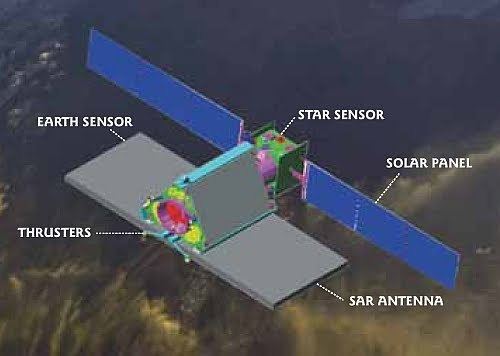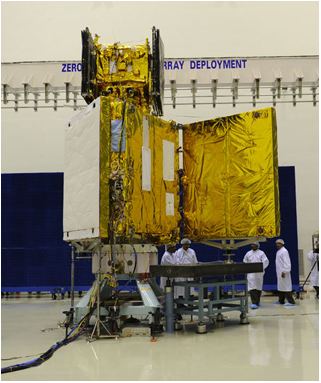Operator ISRO SATCAT no. 38248 Launch date 26 April 2012 Inclination 97° Cost 3.8 billion INR | COSPAR ID 2012-017A Mission duration 5 years (planned) Inclination 97° Launch mass 1,858 kg | |
Website www.isro.gov.in/Spacecraft/risat-1 Similar RISAT‑2, Resourcesat‑1, Cartosat‑1, Oceansat‑2, Cartosat‑2 | ||
India s risat 1 satellite utility capability
Radar Imaging Satellite 1, or RISAT-1, is an Indian remote sensing satellite which was built and is operated by the Indian Space Research Organisation (ISRO). The second RISAT satellite to be launched, it uses C-band 5.35 GHz Synthetic Aperture Radar for earth observation irrespective of the light and weather conditions of the area being imaged.
Contents
- India s risat 1 satellite utility capability
- Risat 1 satellite launched using india s polar satellite launch vehicle pslv c19 mission
- Spacecraft
- Launch
- Incidents
- References
The launch of RISAT-1 came several years after that of RISAT-2, which carried an Israeli-built X-band radar. The RISAT-2 mission was prioritised over RISAT-1 following the 2008 Mumbai attacks, resulting in RISAT-1 being delayed by several years.
Risat 1 satellite launched using india s polar satellite launch vehicle pslv c19 mission
Spacecraft

RISAT-1 had a mass at liftoff of 1,858 kilograms (4,096 lb), making it the heaviest earth observation satellite to be launched by India, and the heaviest satellite to be launched using a Polar Satellite Launch Vehicle. It has the capability to take images of Earth during day and night, as well as in cloudy conditions.
The satellite is equipped with a 160 × 4 Mbps data handling system, 50 Newton-metre-second reaction wheels, and a phased array antenna with dual polarisation. Its synthetic aperture radar has a resolution of 3m-50m. It also supports a spotlight mode for prolonged focus on a given geographical area at a resolution of 1m. Most of the design and the installation of basic instrument subsystems for the satellite was conducted in 2010.

The mission has an approximate cost of ₹4.9 billion (US$73 million);the spacecraft itself cost ₹3.78 billion (US$56 million) to develop, and a further ₹1.1 billion (US$16 million) to launch. The satellite has a design life of five years.

Synthetic aperture radar allows RISAT-1 to collect data during both day and night and in all weather conditions. The satellite is intended to be used for natural resources management, primarily agriculture planning and forestry surveys, as well as to predict and prevent flooding. It will be used for monitoring paddy plantations and yields in the kharif season and to assist India's food security planning. Pictures from RISAT-1 will be used to estimate the number of hectares being farmed in India, to assess crop health and predict total yield. They can also be used to identify wreckage from aircraft which go down in forested areas. RISAT-1 was not designed as a surveillance satellite, given its reliance on the C-band.
According to ISRO scientists, once the satellite onboard propulsion system will raise the orbital altitude to 536 km with orbital inclination of approximately 97 degrees to place the RISAT-1 into a polar sun-synchronous orbit, the satellite will begin its daily routine of 14 orbits with a repetitive cycle of 25 days. During its mission life of five years, RISAT-1 will use its active microwave remote sensing capability for cloud penetration and day-night imaging of the earth surface and provide critical data inputs for a range of applications.
Launch
RISAT-1 was successfully launched at 00:17 UTC (05:47 IST) on 26 April 2012 by a Polar Satellite Launch Vehicle, flight number C19, flying in the PSLV-XL configuration with enhanced solid rocket boosters. The launch, which was the third flight of the PSLV-XL configuration, took place from the First Launch Pad of the Satish Dhawan Space Centre in Sriharikota, Andhra Pradesh. The launch marked the twenty-first flight of the PSLV, and its nineteenth successful launch.
Incidents
On 30 September 2016, Joint Space Operations Center identified a debris generating event near RISAT-1. The event created 16 pieces out of which 15 decayed and one was catalogued on 6 October 2016 under NORAD ID: 41797 and COSPAR ID: 2012-017C and decayed on 12 October 2016. Cause of this event is unknown.
